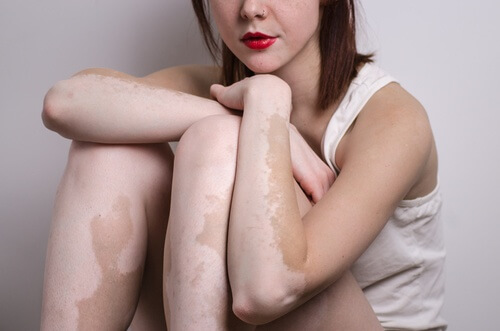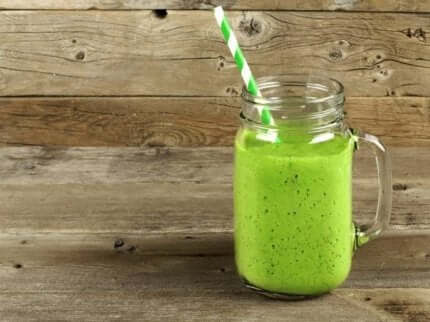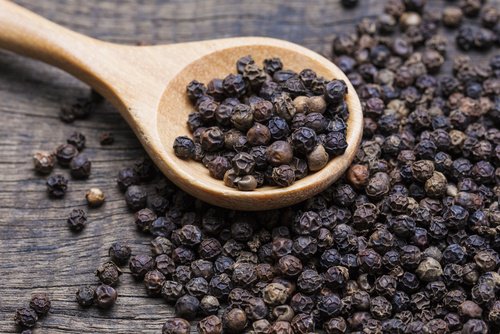9 Natural Remedies that May Help With Vitiligo

According to popular wisdom, there are several natural remedies for vitiligo. These are intended as supplements to a proper diet and, of course, a healthy lifestyle.
The remedies are mainly drinks and syrups that are believed to help boost defenses and improve skin health, among other issues. Are you curious to know more about this? In that case, keep reading everything we’re going to tell you about.
A little more about vitiligo
Vitiligo is a skin disease that although it doesn’t have a cure yet, it does have a treatment. According to Dr. Shinjita Da, the treatment consists mainly of using daily sun protection (suitable clothing and sunscreen), topical medications (creams with corticosteroids and calcipotriene, among other substances), phototherapy, psoralens and, as the case may be, whitening of unaffected skin and surgery.
According to the MSD Manual, this disease can affect up to two percent of the population. The extent of the skin patches and the speed with which the color loss occurs remain unpredictable. Therefore, there are still certain difficulties when treating it.
Mayo Clinic experts explain that treatment doesn’t prevent continued loss of skin color or prevent it from recurring.
Possible causes and main manifestations
The characteristic white or pink patches or spots unpredictably appear mostly on the face, chest, hands, armpits, and groin.

The exact causes of vitiligo, which affects children, young people, and the elderly alike, beyond their ethnicity, age, and sex, aren’t yet known. However, the following factors may influence the development of the disease:
- Stress.
- Wounds
- Heritage.
- Diabetes mellitus.
- Pernicious anemia.
- Hormonal changes.
- Addison’s disease.
- Mood disorders.
- Thyroid gland malfunction.
The relationship between vitiligo and the immune system
Beyond these possible causes, the most widespread theory is that it’s caused by an immune system problem. The body reacts differently to white blood cells, it considers them a harmful invader and, therefore, destroys them.
While it isn’t a serious or life-threatening illness, it’s somewhat bothersome and can even embarrass some people.
What’s known as “spontaneous repigmentation” occurs in a quarter of patients. Among the factors for this to happen we can highlight:
- Recent onset (no more than 6 months).
- Age of the patient (if they’re young).
- Location of the spots (facial area, except for the lips).
Home remedies that may help with vitiligo
Although they don’t have a scientific basis, according to popular wisdom, these remedies can contribute to skin health and reinforce the treatment for vitiligo. We should note that they’re designed as supplements for a healthy lifestyle.
1. Natural smoothie for vitiligo

- 1/2 a cucumber
- Aloe vera gel.
- 1 natural yogurt (125 g).
Preparation
- In a blender, place the cut half cucumber, a pot of natural yogurt, and the gel of an aloe vera.
- Mix until you get a smooth milkshake.
- Serve and consume in moderation within a healthy lifestyle.
- Note: Aloe vera can be substituted for a piece of fruit that’s high in antioxidants.
2. Wheat germ oil may also help with vitiligo
It’s said that the application of wheat germ oil could help mitigate blemishes and, at the same time, slow their expansion to other skin areas. This would be due to its B vitamins and vitamin E.
To take advantage of it, you’d only have to do the following:
- Soak a cotton ball with wheat germ oil and generously spread over the stains.
- After five minutes, or when it’s been absorbed, the area can be covered. You don’t need to wash or rinse.
3. Bee pollen and kiwi smoothie
It’s said that this drink could provide the skin with the nutrients it needs to be healthy. Although the original recipe is made with bee pollen, you can also make it with honey
Ingredients
- 1 tablespoon of bee pollen (15 g).
- 1 kiwi.
Preparation
- Before breakfast, prepare a mixture with one tablespoon of bee pollen and one peeled and sliced kiwi.
- Put in the blender and mix well.
- Consume it daily, within a balanced diet.
4. Black pepper

This widely used spice in cooking is believed to have the ability to increase melanin production in the skin.
One of the main compounds in pepper is piperine, which stimulates the generation of melanocytes. In order to enjoy these benefits, it must be used externally.
In some stores, you can get creams or oils with black pepper as the main component, but you can also make them at home in the following way.
Ingredients
- 1/4 cup of black peppercorns (62 g).
- 1 cup of olive oil (200 g).
Preparation
- Firstly, warm the olive oil on a moderate heat and add the black pepper.
- Leave it to cook for five minutes.
- After this time, remove from the heat, let it cool, and filter the liquid into a glass bottle or jar.
- Apply to the affected areas with cotton wool every day.
What’s the best thing for vitiligo?
To treat vitiligo properly, it’s best to follow the treatment prescribed by your doctor. Likewise, it’s advisable to consult with them about the use of the natural remedies we have just mentioned so that you know which could be the best for you and why.
Remember that if you don’t see your doctor first, you risk various adverse reactions and worsen the condition. Therefore, don’t underestimate your doctor’s support.
All cited sources were thoroughly reviewed by our team to ensure their quality, reliability, currency, and validity. The bibliography of this article was considered reliable and of academic or scientific accuracy.
-
Whitton, M. E., Ashcroft, D. M., & González, U. (2008). Therapeutic interventions for vitiligo. Journal of the American Academy of Dermatology. https://doi.org/10.1016/j.jaad.2008.06.023
-
Abu Tahir, M., Pramod, K., Ansari, S. H., & Ali, J. (2010). Current remedies for vitiligo. Autoimmunity Reviews. https://doi.org/10.1016/j.autrev.2010.02.013
-
Gawkrodger, D. J., Ormerod, A. D., Shaw, L., Mauri-Sole, I., Whitton, M. E., Watts, M. J., … Young, K. (2011). Vitiligo: Guidelines for the Diagnosis and Management of Vitiligo. In British Association of Dermatologists’ Management Guidelines. https://doi.org/10.1002/9781444329865.ch1
This text is provided for informational purposes only and does not replace consultation with a professional. If in doubt, consult your specialist.








